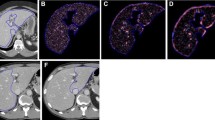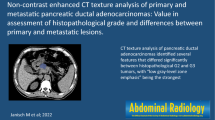Abstract
Purpose
To explore the value of CT texture analysis (CTTA) for differentiation of focal nodular hyperplasia (FNH) from hepatocellular adenoma (HCA) on contrast-enhanced CT (CECT).
Methods
This is a retrospective, IRB-approved study conducted in a single institution. A search of the medical records between 2008 and 2017 revealed 48 patients with 70 HCA and 50 patients with 62 FNH. All lesions were histologically proven and with available pre-operative CECT imaging. Hepatic arterial phase (HAP) and portal venous phase (PVP) were used for CTTA. Textural features were extracted using a commercially available research software (TexRAD). The differences between textural parameters of FNH and HCA were assessed using the Mann–Whitney U test and the AUROC were calculated. CTTA parameters showing significant difference in rank sum test were used for binary logistic regression analysis. A p value < 0.05 was considered statistically significant.
Results
On HAP images, mean, mpp, and skewness were significantly higher in FNH than in HCA on unfiltered images (p ≤ 0.007); SD, entropy, and mpp on filtered analysis (p ≤ 0.006). On PVP, mean, mpp, and skewness in FNH were significantly different from HCA (p ≤ 0.001) on unfiltered images, while entropy and kurtosis were significantly higher in FNH on filtered images (p ≤ 0.018). The multivariate logistic regression analysis indicated that the mean, mpp, and entropy of medium-level and coarse-level filtered images on HAP were independent predictors for the diagnosis of HCA and a model based on all these parameters showed the largest AUROC (0.824).
Conclusions
Multiple explored CTTA parameters are significantly different between FNH and HCA on CECT.





Similar content being viewed by others
References
Nault JC, Couchy G, Balabaud C, et al. (2017) Molecular classification of hepatocellular adenoma associates with risk factors, bleeding, and malignant transformation. Gastroenterology 152(880–894):e6
Navarro AP, Gomez D, Lamb CM, Brooks A, Cameron IC (2014) Focal nodular hyperplasia: a review of current indications for and outcomes of hepatic resection. HPB (Oxford) 16:503–511
Ruppert-Kohlmayr AJ, Uggowitzer MM, Kugler C, et al. (2001) Focal nodular hyperplasia and hepatocellular adenoma of the liver: differentiation with multiphasic helical CT. AJR Am J Roentgenol 176:1493–1498
Agarwal S, Fuentes-Orrego JM, Arnason T, et al. (2014) Inflammatory hepatocellular adenomas can mimic focal nodular hyperplasia on gadoxetic acid-enhanced MRI. AJR Am J Roentgenol 203:W408–W414
Davnall F, Yip CS, Ljungqvist G, et al. (2012) Assessment of tumor heterogeneity: an emerging imaging tool for clinical practice? Insights Imaging 3:573–589
Ganeshan B, Miles KA (2013) Quantifying tumour heterogeneity with CT. Cancer Imaging 13:140–149
Sadot E, Simpson AL, Do RK, et al. (2015) Cholangiocarcinoma: correlation between molecular profiling and imaging phenotypes. PLoS ONE 10:e0132953
Kiryu S, Akai H, Nojima M, et al. (2017) Impact of hepatocellular carcinoma heterogeneity on computed tomography as a prognostic indicator. Sci Rep 7:12689
Mulé S, Thiefin G, Costentin C, et al. (2018) Advanced hepatocellular carcinoma: pretreatment contrast-enhanced CT texture parameters as predictive biomarkers of survival in patients treated with sorafenib. Radiology 288:445–455
Miles KA, Ganeshan B, Griffiths MR, Young RC, Chatwin CR (2009) Colorectal cancer: texture analysis of portal phase hepatic CT images as a potential marker of survival. Radiology 250:444–452
Ahn SJ, Kim JH, Park SJ, Han JK (2016) Prediction of the therapeutic response after FOLFOX and FOLFIRI treatment for patients with liver metastasis from colorectal cancer using computerized CT texture analysis. Eur J Radiol 85:1867–1874
Beckers RCJ, Lambregts DMJ, Schnerr RS, et al. (2017) Whole liver CT texture analysis to predict the development of colorectal liver metastases—a multicentre study. Eur J Radiol 92:64–71
Lubner MG, Stabo N, Lubner SJ, et al. (2015) CT textural analysis of hepatic metastatic colorectal cancer: pre-treatment tumor heterogeneity correlates with pathology and clinical outcomes. Abdom Imaging 40:2331–2337
Chang CC, Chen HH, Chang YC, et al. (2017) Computer-aided diagnosis of liver tumors on computed tomography images. Comput Methods Progr Biomed 145:45–51
Raman SP, Schroeder JL, Huang P, et al. (2015) Preliminary data using computed tomography texture analysis for the classification of hypervascular liver lesions: generation of a predictive model on the basis of quantitative spatial frequency measurements–a work in progress. J Comput Assist Tomogr 39:383–395
Chen S, Zhu Y, Liu Z, Liang C (2017) Texture analysis of baseline multiphasic hepatic computed tomography images for the prognosis of single hepatocellular carcinoma after hepatectomy: a retrospective pilot study. Eur J Radiol 90:198–204
Ganeshan B, Miles KA, Young RC, Chatwin CR (2007) Hepatic entropy and uniformity: additional parameters that can potentially increase the effectiveness of contrast enhancement during abdominal CT. Clin Radiol 62:761–768
Miles KA, Ganeshan B, Hayball MP (2013) CT texture analysis using the filtration-histogram method: what do the measurements mean? Cancer Imaging 13:400–406
Perrakis A, Demir R, Müller V, et al. (2012) Management of the focal nodular hyperplasia of the liver: evaluation of the surgical treatment comparing with observation only. Am J Surg 204:689–696
Stoot JH, Coelen RJ, De Jong MC, Dejong CH (2010) Malignant transformation of hepatocellular adenomas into hepatocellular carcinomas: a systematic review including more than 1600 adenoma cases. HPB (Oxford) 12:509–522
Brancatelli G, Federle MP, Grazioli L, et al. (2001) Focal nodular hyperplasia: CT findings with emphasis on multiphasic helical CT in 78 patients. Radiology 219:61–68
Nowicki TK, Markiet K, Izycka-Swieszewska E, et al. (2018) Efficacy comparison of multi-phase CT and hepatotropic contrast-enhanced MRI in the differential diagnosis of focal nodular hyperplasia: a prospective cohort study. BMC Gastroenterol. 18:10
Shen YH, Fan J, Wu ZQ, et al. (2007) Focal nodular hyperplasia of the liver in 86 patients. Hepatobiliary Pancreat Dis Int 6:52–57
Bonney GK, Gomez D, Al-Mukhtar A, et al. (2007) Indication for treatment and long-term outcome of focal nodular hyperplasia. HPB (Oxford) 9:368–372
Choi CS, Freeny PC (1998) Triphasic helical CT of hepatic focal nodular hyperplasia: incidence of atypical findings. AJR Am J Roentgenol 170:391–395
Carlson SK, Johnson CD, Bender CE, Welch TJ (2000) CT of focal nodular hyperplasia of the liver. AJR Am J Roentgenol 174:705–712
Winterer JT, Kotter E, Ghanem N, Langer M (2006) Detection and characterization of benign focal liver lesions with multislice CT. Eur Radiol 16:2427–2443
Hussain SM, van den Bos IC, Dwarkasing RS, Kuiper JW, den Hollander J (2006) Hepatocellular adenoma: findings at state-of-the-art magnetic resonance imaging, ultrasound, computed tomography and pathologic analysis. Eur Radiol 16:1873–1886
Ichikawa T, Federle MP, Grazioli L, Nalesnik M (2000) Hepatocellular adenoma: multiphasic CT and histopathologic findings in 25 patients. Radiology 214:861–868
McInnes MD, Hibbert RM, Inácio JR, Schieda N (2015) Focal nodular hyperplasia and hepatocellular adenoma: accuracy of gadoxetic acid-enhanced MR imaging—a systematic review. Radiology 277:413–423
Guo Y, Li W, Xie Z, et al. (2017) Diagnostic value of Gd-EOB-DTPA-MRI for Hepatocellular adenoma: a meta-analysis. J Cancer 8:1301–1310
Balabaud C, Al-Rabih WR, Chen PJ, et al. (2013) Focal nodular hyperplasia and hepatocellular adenoma around the world viewed through the scope of the immunopathological classification. Int J Hepatol 2013:268625
Bioulac-Sage P, Rebouissou S, Thomas C, et al. (2007) Hepatocellular adenoma subtype classification using molecular markers and immunohistochemistry. Hepatology 46:740–748
Yasaka K, Akai H, Mackin D, et al. (2017) Precision of quantitative computed tomography texture analysis using image filtering: a phantom study for scanner variability. Medicine (Baltimore) 96:e6993
Author information
Authors and Affiliations
Corresponding author
Ethics declarations
Funding
No funding was received for this study.
Conflict of interest
The authors declare that they have no conflict of interests.
Disclosure
Alessandro Furlan: research grant from General Electric; consultant for General Electric; book contract with Elsevier/Amirsys. Amir A. Borhani: consultant for Guebert; consultant for Elsevier/Amirsys.
Ethical approval
All procedures performed in studies involving human participants were in accordance with the ethical standards of the institutional and/or national research committee and with the 1964 Helsinki declaration and its later amendments or comparable ethical standards.
Informed consent
For this type of study formal consent is not required.
Rights and permissions
About this article
Cite this article
Cannella, R., Borhani, A.A., Minervini, M.I. et al. Evaluation of texture analysis for the differential diagnosis of focal nodular hyperplasia from hepatocellular adenoma on contrast-enhanced CT images. Abdom Radiol 44, 1323–1330 (2019). https://doi.org/10.1007/s00261-018-1788-5
Published:
Issue Date:
DOI: https://doi.org/10.1007/s00261-018-1788-5




